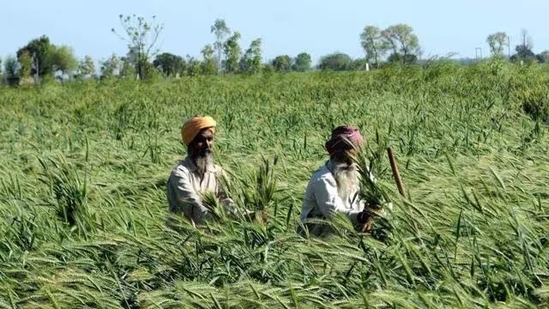How government reforms are boosting farmer incomes
This article is authored by Pilot Neeraj Sehrawat and Mukesh Kestwal.
Agriculture has been the backbone of India's economy, and the government has taken decisive steps to ensure that farmers receive the support and resources necessary to enhance their income and sustain agricultural productivity. Recognising that agriculture is a state subject, the Government of India has significantly strengthened its role by providing policy measures, budgetary support, and a comprehensive range of schemes that empower farmers and ensure sustainable growth.

One of the most impactful steps taken by the government has been the substantial increase in budget allocation for the Department of Agriculture & Farmers Welfare (DA&FW), from ₹21,933.50 crore in 2013-14 to ₹1,22,528.77 crore in 2024-25. This sharp rise reflects the government’s unwavering commitment to boosting agricultural development through well-structured schemes designed to enhance production, secure remunerative returns, and provide direct income support to farmers. Key initiatives include:
· Pradhan Mantri Kisan Samman Nidhi (PM-KISAN): A direct benefit transfer scheme providing ₹6,000 annually to farmers, ensuring financial stability for their agricultural needs.
· Pradhan Mantri Fasal Bima Yojana (PMFBY): A robust crop insurance scheme safeguarding farmers against unpredictable climatic and market risks.
· Modified Interest Subvention Scheme (MISS): Offering concessional short-term agricultural loans through Kisan Credit Cards at a subsidised rate of 7%, with a 3% Prompt Repayment Incentive, effectively reducing the interest rate to just 4%.
· Formation and Promotion of 10,000 Farmer Producer Organisations (FPOs): Empowering small and marginal farmers by improving collective bargaining power and access to markets.
· Agriculture Infrastructure Fund (AIF): Aiming to strengthen post-harvest management and infrastructure to reduce wastage and enhance value addition.
· Digital Agriculture Mission & National Mission on Natural Farming: Integrating technology and sustainable practices into agriculture to enhance productivity and environmental conservation.
The effectiveness of these initiatives is evident through real-world success stories. The Indian Council of Agricultural Research (ICAR) has documented case studies of 75,000 farmers who have successfully doubled their income by leveraging these schemes in convergence with other allied programmes. Furthermore, the National Sample Survey Office (NSSO) data reveals a substantial increase in the estimated average monthly income per agricultural household from ₹6,426 in 2012-13 to ₹10,218 in 2018-19, highlighting the direct benefits reaching farmers.
A pivotal measure in securing farmers’ income has been the government’s focus on fair pricing through:
· Minimum Support Prices (MSPs): Ensuring a return of at least 50% over the cost of production for 22 mandated crops.
· Pradhan Mantri Annadata Aay Sanrakshan Abhiyan (PM-AASHA): Implementing price support and deficiency payment mechanisms to protect farmers from price fluctuations.
· National Agriculture Market (e-NAM): A revolutionary digital platform that connects farmers directly with buyers, eliminating middlemen and ensuring better price realisation.
Recognising the need to move beyond traditional water-intensive crops, the government has launched the Crop Diversification Programme (CDP) in key Green Revolution states, encouraging the cultivation of pulses, oilseeds, and millets. Additionally, the National Food Security Mission (NFSM) and Mission for Integrated Development of Horticulture (MIDH) are promoting high-value crops that ensure better returns for farmers while conserving natural resources.
Since its inception in 2019, PM-KISAN has transformed the lives of farmers across India. To ensure no eligible farmer is left behind, the government launched a major saturation drive under Viksit Bharat Sankalp Yatra in November 2023, bringing over one crore additional farmers under its ambit. Another drive in June 2024 resulted in the inclusion of 25 lakh more beneficiaries within the first 100 days of the new government. The 18th installment of the scheme benefitted 9.59 crore farmers, reinforcing the transparency and efficiency of digital governance in agriculture.
The government is not only focused on immediate relief but also on long-term agricultural transformation. With the vision of Viksit Bharat@2047, strategic initiatives across multiple domains—market reforms, digital integration, climate resilience, and financial support—are set to shape the future of Indian agriculture, ensuring prosperity for generations of farmers. The Modi-led government has laid a strong foundation for the holistic development of the agricultural sector, ensuring that farmers receive the rightful economic benefits of their labour. The increase in budgetary allocation, convergence of farmer-centric schemes, direct benefit transfers, and enhanced market linkages have collectively propelled India towards achieving its goal of doubling farmers’ income. As these policies continue to evolve and expand, the future of Indian agriculture stands resilient, progressive, and prosperous. To sustain this momentum, continued collaboration between policymakers, industry leaders, and farmers is essential. Strengthening cooperative models, enhancing digital literacy among farmers, and further expanding access to credit and infrastructure will be key to realising the vision of a self-reliant and globally competitive Indian agricultural sector.
This article is authored by Pilot Neeraj Sehrawat, national In-chargem, research & policy, BJP Kisan Morcha and Mukesh Kestwal, chief innovation officer, IIT Ropar.
All Access.
One Subscription.
Get 360° coverage—from daily headlines
to 100 year archives.



HT App & Website







